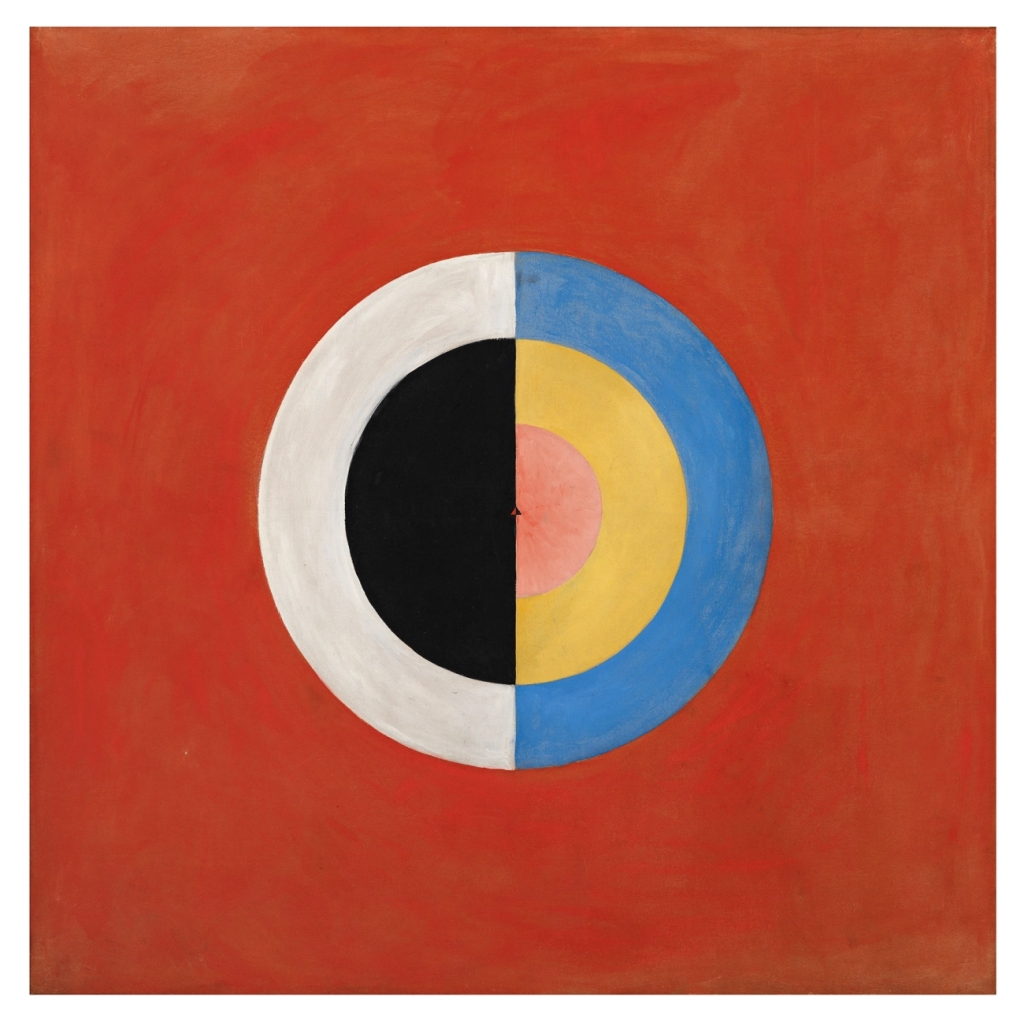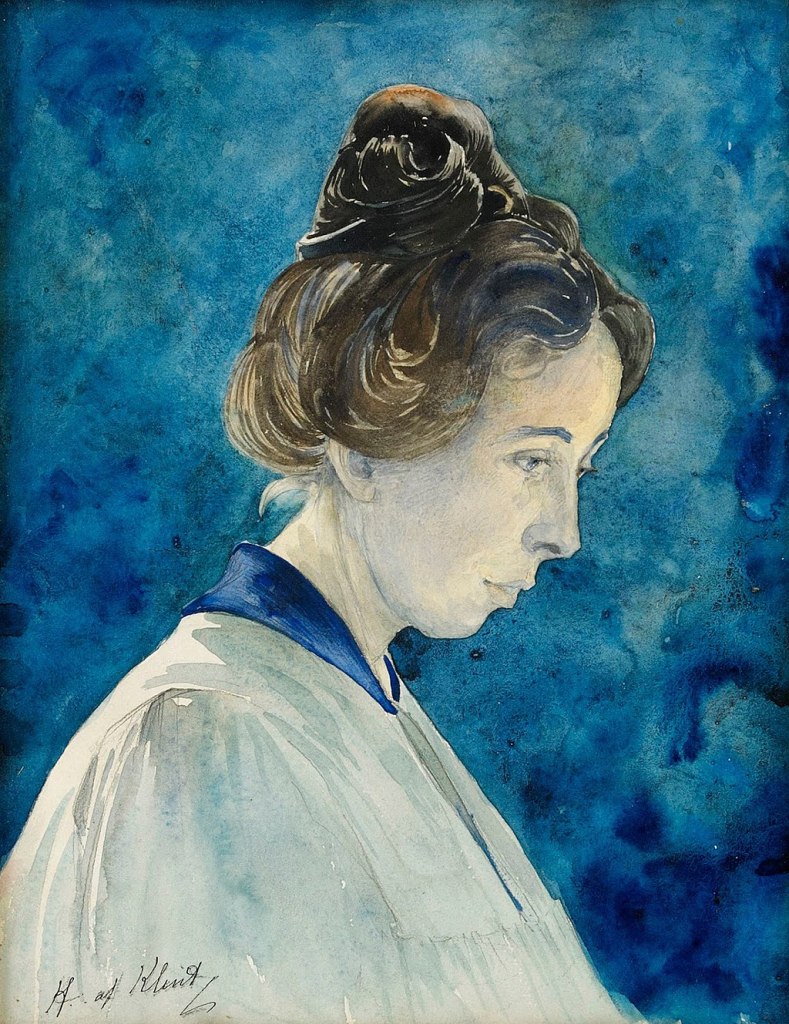
Parsifal Grupp II, No. 69
1916
© Stiftelsen Hilma af Klints Verk
Art history needs new editing everywhere.
The great awakening, like any uprising, has its victims. Nevertheless, “don’t throw the baby out with the bath water”! There’s much to learn from feminism and post-feminism, as from post-colonial studies, critical race theory, gender issues, climate change, unsustainable growth, unfair globalization, and pronouns. The Eurocentric male chauvinist is not an empty box but someone who negatively marked the last six centuries worldwide. This lens is not the only one, though. But yes, there are too many poisoned ideas that need to go.
The case of Hilma af Klint, an extraordinary Swedish artist who preceded Mondrian and Malevich in ‘non-objective art’, reminds us that the winners frequently write history books, but only as they keep being the winners.

The Swan, No. 17, Group IX/SUW, The SUW/UW Series
1915
© Courtesy Stiftelsen Hilma af Klints Verk
Photo: Albin Dahlström/Moderna Museet
Hilma af Klint: Paintings for the Future
Guggenheim, New York
October 12, 2018–April 23, 2019
When Hilma af Klint began creating radically abstract paintings in 1906, they were like little that had been seen before: bold, colorful, and untethered from any recognizable references to the physical world. It was years before Vasily Kandinsky, Kazimir Malevich, Piet Mondrian, and others would take similar strides to rid their own artwork of representational content. Yet while many of her better-known contemporaries published manifestos and exhibited widely, af Klint kept her groundbreaking paintings largely private. She rarely exhibited them and, convinced the world was not yet ready to understand her work, stipulated that it not be shown for twenty years following her death. Ultimately, her work was all but unseen until 1986, and only over the subsequent three decades have her paintings and works on paper begun to receive serious attention.

No. 2a, The Current Standpoint of the Mahatmas (Nr 2a, Mahatmernas nuvarande ståndpunkt)
1920
From Series II (Serie II)
Oil on canvas, 36.5 x 27cm
© The Hilma af Klint Foundation, Stockholm
Photo: Albin Dahlström, the Moderna Museet, Stockholm
First group exhibition
1986 – 1987
The Spiritual in Art – Abstract Painting 1890 – 1985
Los Angeles County Museum of Art, Los Angeles, USA.
November 23, 1986 – March 08, 1987
First solo exhibition
1988
Hilma af Klints hemliga bilder (The Secret Paintings of Hilma af Klint)
Nordiskt Konstcentrum, Helsinki, Finland.
August 06 – October 02, 1988
2023, ongoing exhibitions
Bozar, Brussels — Swedish Ecstasy (17 Feb–21 May 2023)
Tate Modern, London — Hilma af Klint & Piet Mondrian: Forms of Life (20 April–3 September 2023) | Ocula

Group I, Primordial Chaos, No. 15
1906-1907
© Stiftelsen Hilma af Klints Verk
Hilma af Klint exhibitions/ The Hilma AF Klint Foundation

Guggenheim, New York
October 12, 2018–April 23, 2019
Legacy
In her will, Hilma af Klint left all her abstract paintings to her nephew, vice-admiral Erik af Klint of the Royal Swedish Navy. She specified that her work should be kept secret for at least 20 years after her death. When the boxes were opened at the end of the 1960s, very few persons had knowledge of what would be revealed.
In 1970 her paintings were offered as a gift to Moderna Museet i Stockholm, but the donation was declined. Erik af Klint then donated thousands of drawings and paintings to a foundation bearing the artist’s name in the 1970s.[32] Thanks to the art historian Åke Fant, her art was introduced to an international audience in the 1980s, when he presented her at a Nordik conference in Helsinki in 1984.
The collection of abstract paintings of Hilma af Klint includes more than 1200 pieces. It is owned and managed by the Hilma af Klint Foundation in Stockholm, Sweden. In 2017, Norwegian architectural firm Snøhetta presented plans for an exhibition centre dedicated to af Klint in Järna, south of Stockholm, with estimated building costs of €6 to 7.5 million. In February 2018, the Foundation signed a long-term agreement of cooperation with the Moderna Museet, thereby confirming the perennity of the Hilma af Klint Room, i.e., a dedicated space at the museum where a dozen works of the artist are shown on a continuous basis.
— in Wikipedia (retrieved on 2023/4/25)

Self Portrait
Unknown date (around 1880)
New biography and seven-volume catalogue raisonné bring order to the spiritual fascination of Hilma af Klint
Hilma af Klint (1862-1944) is an artist whose time has come. The fascination with the Swedish artist’s work has grown since the 2013 retrospective at the Moderna Museet in Stockholm, and reached a high point with the 2018 Guggenheim exhibition in New York. Painting at the behest of “higher spirits”, Af Klint embraced the spiritualist beliefs of Rosicrucianism, Theosophy and Anthroposophy, while remaining open to contemporary scientific developments (from x-rayographs to research into atoms), which similarly penetrated superficial reality. Her paintings transformed these various sources into an individual imagery that ultimately fulfils her prediction that “the attempts I have undertaken … will astound humanity”.
— in The Art Newspaper, 2022/11/07
Last but not least
Hilma, a movie by Lasse Hallström.
I have seen Lass Hallström’s film on Hilma af Klint tonight @ Bozart (Brussels, April 26, 2023). It is a beautiful movie, made with great expertise and sensibility. A homage to women and to the art world. Great photography, too.

Leave a comment